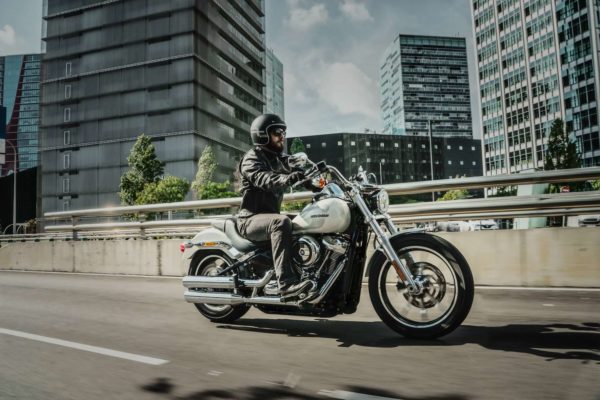Choosing motorbike oil coolers can indeed be a complex topic where numerous people make mistakes by choosing the wrong motorbike oil coolers for their motorbike. That’s why the question arises, How do you choose the right size and type of oil cooler for your motorcycle?
While choosing the oil coolers for your motorbike, you should consider engine size and type, riding conditions, and cooling system components. You should also consider heat dissipation capacity, cooling find and surface area, and airflow considerations while choosing motorbike oil coolers.
Let’s consider what it means and what you can do about it.
While writing this post, I leave no stone unturned so you can know everything about choosing the right size and type of oil cooler for your motorcycle.
Table of Contents
How Do You Choose the Right Size and Type of Oil Cooler for Your Motorcycle?
Maintaining optimal engine temperature is crucial for maximizing performance and prolonging the life of your motorcycle’s engine. The right oil cooler size and type are vital for effective cooling and overall performance.
In this article, we will explore the key factors to consider when choosing an oil cooler, including engine size and type, riding conditions, and compatibility with the motorcycle’s cooling system. By understanding these factors, you can make an informed decision and ensure your motorcycle benefits from optimal cooling and performance.
While choosing the oil coolers for your motorbike, you should consider engine size and type, riding conditions, and cooling system components. You should also consider heat dissipation capacity, cooling find and surface area, and airflow considerations while choosing motorbike oil coolers.
Understanding the Factors:
Engine Size and Type:
The engine type and size directly influence your motorbike’s heat generated and cooling requirements. A vast engine has a higher displacement which tends to produce more heat, thus requiring a larger oil cooler to effectively reduce the motorbike oil heat.
High-performance engines such as motorbike engines found in sports motorbikes or cruisers commonly demand more efficient and robust cooling systems to handle the excellent heat output. Smaller engines may require a more minor oil cooler system to achieve a sound cooling system without sacrificing engine performance.
Overall, you’ll require more complex oil cooling systems like coolant-based motorbike oil coolers if your motorbike has a vast engine that produces more heat and vice versa.
Riding Conditions:
Riding conditions also influence choosing the motorbike cooling system. For instance, climate and terrain can significantly affect engine temperature.
Suppose you frequently ride in hot climates or engage in off-road adventures and put a lot of additional stress on the engine. A larger cooler with a fantastic cooling system might be helpful.
Long-distance touring riders may also benefit from a good or larger oil cooler to ensure better cooling during the long hours of continually riding.
Cooling System Compatibility:
Ensure you choose oil coolers most compatible with your motorbike’s existing cooling system. Always consider factors such as coolant type and space available for installation.
Don’t forget that an oil cooler should integrate seamlessly into your motorbike system to avoid any potential; leaks or compatibility issues.
Always consult your motorcycle’s manufacturer guidelines to seek advice from a trusted mechanic to ensure that oil coolers match perfectly with your motorbike needs.
Choosing the Right Size Motorbike Oil Coolers:
Heat Dissipation Capacity:
The heat dissipation capacity of an oil cooler is also a crucial factor that you should consider before buying the motorbike oil cooler for your motorbike.
Heat dissipation capacity directly influenced the cooling ability of motorbike oil coolers. Choosing an oil cooler with sufficient cooling capacity is crucial to dissipate the engine’s heat effectively.
By selecting the ideal and suited motorbike oil cooler, you can rest assured that your engine won’t suffer from heat dissipation and will always give the best performance without overheating and any wear and tear.
Cooling Fins and Surface Area:
Indeed heat dissipation capacity is crucial in choosing suitable motorbike oil coolers. However, do you know that cooling fins and the surface area also play a crucial role in choosing motorbike oil coolers?
Cooling fins play a vital role in enhancing heat dissipation in oil coolers.
Cooling fins increase the surface and are available for heat transfer to the surroundings for more efficient cooling. When choosing an oil cooler, don’t forget to consider the number and design of the cooling system.
The more cooling fins provide a larger surface area, leading to improved cooling efficiency, and by opting for a cooler with larger cooling fins, you can rest assured that your motorbike won’t suffer from overheating.
Airflow Considerations:
Along with the cooling and large surface area fins, the airflow is also a primary consideration when choosing motorbike oil coolers.
It’s because proper airflow is essential for the easy operation of an air cooler, and factors such as oil cooler placement, presence of fairings, and presence of other cooling fans impact the airflow reaching the oil cooler.
It’s crucial to ensure that oil coolers are placed in an area where they can get adequate airflow so that your motorbike engine can become calm. In some cases, installing additional cooling fans can improve airflow and cooling, particularly in demanding riding conditions or when operating in high-temperature environments.
Selecting the Appropriate Type:
Air-Cooled Oil Coolers:
So far, you understand how focusing on the airflow can maximize the oil cooling mechanism; now, the question that arises is how air-cooled oil coolers impact the motorbike cooling system.
Air-cooled oil coolers utilize the natural airflow around the motorbike to lose heat to the outer environment. They’re suitable for the motorbike with sufficient airflow and moderating cooling needs.
They’re easy and compact to install can provide efficient cooling for everyday riding needs, and are commonly used in cruisers and standard motorbikes.
Liquid-Cooled Oil Coolers:
Liquid-cooled oil coolers are designed to handle the vast engine and its higher cooling demands or riding conditions. It has a separate cooling system, typically connected to the motorcycle’s radiator, to remove hair from the motorbike radiators.
It’s highly beneficial for high-performance motorcycles, sports, adventure motorcycles, or motorbikes you ride with a heavy engine for hours.
They always ensure cooling even if the weather isn’t favorable to your engine cooling needs and are thus far better than air-cooled oil coolers.ṣ
Combination Systems:
Liquid-cooled oil coolers and air-cooled oil coolers have their advantages and disadvantages. What better than combining both to diminish their disadvantages and use their advantages?
Combining both oil cooling systems offers your motorbike extra edge cooling performance. They integrated both systems to enhance the cooling performance.
These systems are ideal for motorbikes that demand maximum cooling efficacy, such as racing motorbikes ridden in extreme or unforgivable weather conditions.
By combining these systems, you can rest assured that your motorbike will never suffer from extraordinary overheating, and you’ll get the maximum performance every time.
When selecting an oil cooler for your motorcycle, it is crucial to consider the brand’s reputation and the quality of its products.
Opting for a reputable brand ensures you invest in a well-engineered and reliable oil cooler. Look for brands with a track record of manufacturing high-quality motorcycle cooling systems.
Consider reliability, durability, and customer feedback when evaluating different brands. Additionally, check if the brand offers a warranty for its oil coolers, as it provides added assurance and protection for your investment.
Installation and Maintenance:
Proper installation and regular maintenance are essential for your oil cooler’s optimal performance and longevity.
During installation, ensure that you follow the manufacturer’s guidelines and recommendations. This includes correctly mounting the oil cooler, making secure hose connections, and verifying compatibility with your motorcycle’s cooling system.
Suppose you are unsure about the installation process. In that case, it is advisable to seek the assistance of a professional mechanic to ensure a proper fit and avoid any potential issues.
Routine maintenance is crucial to keep your oil cooler in optimal condition. Follow the manufacturer’s maintenance instructions, including periodic cleaning, inspecting fittings and hoses, and checking for any signs of damage or leaks.
Adhering to the recommended maintenance intervals ensures that the oil cooler continues to provide adequate cooling and prolongs its lifespan. Regular maintenance lets you detect and address any potential issues early on, preventing further damage to your motorcycle’s engine.
Also, read my previous article where I mentioned what are the benefits of installing an oil cooler for a motorbike, CLICK HERE to read more.
Frequently Asked Questions:
Why is it important to choose the right size and type of oil cooler for your motorcycle?
Choosing the right size and type of oil cooler is crucial for maintaining optimal engine temperature, enhancing performance, and prolonging your motorcycle’s engine life. An incorrectly sized or incompatible oil cooler can lead to overheating or inadequate cooling.
How do engine size and type affect the choice of an oil cooler?
Engine size and type directly influence the heat generated and cooling requirements. Larger engines tend to produce more heat and may require a larger oil cooler to effectively manage the excess heat. High-performance engines may also demand more efficient cooling systems.
What role do riding conditions play in selecting an oil cooler?
Riding conditions, such as climate and terrain, can significantly impact engine temperature. Hot climates, off-road riding, or long-distance touring may require larger or more efficient oil coolers to ensure consistent and effective cooling.
Why is it important to consider cooling system compatibility when choosing an oil cooler?
Compatibility with your motorcycle’s existing cooling system is crucial to ensure seamless integration and prevent potential leaks or compatibility issues. Always consult your motorcycle’s manufacturer guidelines or seek advice from a trusted mechanic to ensure a perfect match.
What is the significance of heat dissipation capacity when selecting an oil cooler?
Heat dissipation capacity directly influences the cooling ability of an oil cooler. Choosing an oil cooler with sufficient cooling capacity is essential to effectively dissipate engine heat and prevent overheating.
Final Verdict:
How Do You Choose the Right Size and Type of Oil Cooler for Your Motorcycle? While choosing the oil coolers for your motorbike, you should consider engine size and type, riding conditions, and cooling system components. You should also consider heat dissipation capacity, cooling find and surface area, and airflow considerations while choosing motorbike oil coolers.
Consider additional features such as brand reparations, installation, and maintenance for better cooling.
John, this side! My passion for motorbikes started when I was 12. I experienced many accidents and even lost some friends too. And it inspired me to create this website so that no parents in this world would lose their child while enjoying riding.


